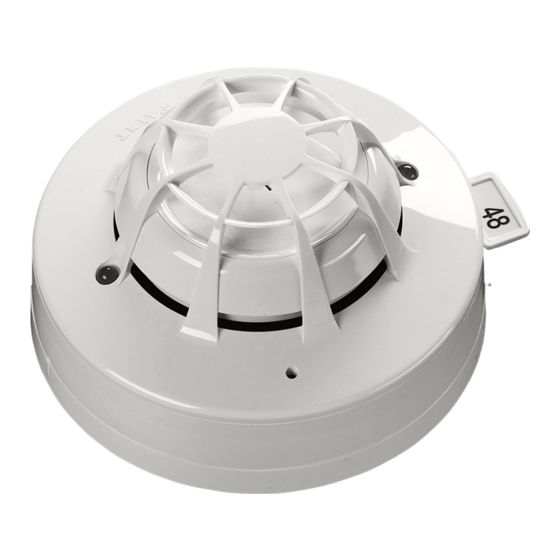
Ampac XP95 Installation Manual
Open-area sounder and sounder visual indicator
Hide thumbs
Also See for XP95:
- Product manual (25 pages) ,
- Installation manual (2 pages) ,
- Product manual (7 pages)
Table of Contents
Advertisement
Quick Links
Functional Test Data
The sounder is loop-powered and controlled by the control panel using the output bits in the
communication protocol.
Troubleshooting
Before investigating individual units for faults, it is important to check the system wiring is fault-
free. Earth faults on data loops may cause communication errors.
Fault Finding
Problem
No response or missing
Analogue value 1
Analogue value 4
Device fault
Device fails to operate
Device diffi cult to fi t to base
Water ingress
Fixing centres 51mm and 60mm, 5mm diameter (max) clearance
Isolator LED
E
L– In
L– Out
L+ In
L+ Out
Mounting Holes
Locking Mechanism
Weatherproof mounting pad
E=Earth/Screen
© Apollo Fire Detectors Limited 2007-10 TP/TB
Fig. 2- Base diagram
7 Ledgar Road, Balcatta, Western Australia 6021
Telephone: +618 9201 6100 Fax: +618 9201 6101
Email: Info@Ampac.net Website: www.Ampac.net
Possible Cause
Incorrect address setting
Incorrect loop wiring (polarity reversed)
Sounder failed
Incorrect group or individual address setting
Incorrect group address setting
Control panel has incorrect cause and effect
programming
Incorrect group address setting
Incorrect tone setting
Insuffi cient lubricant on 'O' ring
Weatherproof mounting pad missing or
damaged
Incorrect cable glands
Damaged base
'O' ring
Ampac
4
39215-213/Issue 1
XP95 Open-Area Sounder and Sounder Visual
General
This guide refers to the Outdoor (Type B) XP95 Open-Area Sounder, but the installation process
is identical for all products listed below:
Item Number
'O' ring
4107-4002
4107-4003
4107-6003
The sounder is connected to control panels which use the Discovery or XP95 protocol. It com-
plies with the requirements of AS7240-3.
The sounder is supplied with an isolating base. A yellow LED is illuminated if a loop short circuit is
detected.
The tones incorporated in the sounder products are:
Australian AS7240-3 Tone, New Zealand NZS4512 Tone & Apollo Standard Tone.
There are two volume settings in each sounder variant.
Installation
1.
Drill out the cable entries and mounting holes as required on the base (using a 20mm hole
cutter for the cable entries), taking care not to damage the electronics. Do not attempt to
knock these out as the base will be damaged.
2.
Secure the base to the mounting surface with pan-head screws. If IP65 integrity is required,
fi t the weatherproof mounting pad between the base and the mounting surface. Fit the
'O' ring to the base (Fig. 2) using a lubricant such as silicone grease.
3.
Set the sounder address using the table overleaf.
4.
To lock the sounder in the base, snip the break-out on the base rim (location shown in Fig. 2).
Fit the sounder to the base.
Indicator Installation Guide
Product Description
XP95 Open-Area Sounder Red Body (AS7240-3)
XP95 Open-Area Sounder White Body (AS7240-3)
XP95 Open-Area Sounder Visual Indicator (AS7240-3)
1
Advertisement
Table of Contents

Summary of Contents for Ampac XP95
- Page 1 4107-4003 XP95 Open-Area Sounder White Body (AS7240-3) 4107-6003 XP95 Open-Area Sounder Visual Indicator (AS7240-3) The sounder is connected to control panels which use the Discovery or XP95 protocol. It com- plies with the requirements of AS7240-3. L– In L– Out...
- Page 2 Technical Data Group Address Setting In group mode the XP95 Open-Area Sounder responds to an additional address referred to as Operating voltage 17–28V dc the group address, which is used to activate groups of sounders simultaneously. Individual units Maximum Loop Current Consumption at 24V continue to respond to their own addresses and report their status in the normal way.




Need help?
Do you have a question about the XP95 and is the answer not in the manual?
Questions and answers